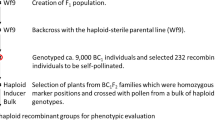Summary
Durum or macaroni wheat (Triticum turgidum L., 2n = 4x = 28; AABB genomes) arose as a natural hybrid between two wild species, Aegilops speltoides Tausch (2n = 2x = 14; BB genome) and Triticum urartu Tumanian (2n = 2x = 14; AA genome). The two progenitors hybridized in nature about half a million years ago and gave rise to tetraploid wheat, presumably in one step as a result of functioning of unreduced gametes in their hybrid BA (amphihaploid). It is easily possible to go back on the evolutionary scale and obtain durum haploids BA, and then regenerate tetraploid durum plants from them. Interestingly, such a reversion to haploidy does occur in nature as well, although at a very low frequency. This article reports on the occurrence of two spontaneous durum haploids and describes their chromosomal characteristics. The haploids (euhaploids, to be precise) had 14 somatic chromosomes, which, on fluorescent genomic in situ hybridization (fl-GISH), could be distinguished as 7 A-genome and 7 B-genome chromosomes. At meiosis, only 2.3 and 2.7% of the chromosomes paired in the two haploids, because of the presence of the homoeologous pairing-suppressor gene, Ph1. The Ph1-induced lack of pairing is a prerequisite for chromosome doubling through the formation of unreduced gametes that give rise to tetraploid durum wheats.
Similar content being viewed by others
References
Almouslem, A.B., P.P. Jauhar, T.S. Peterson, V.R. Bommineni & M.B. Rao, 1998. Haploid durum wheat production via hybridization with maize. Crop Sci 38: 1080–1087.
Coe, E.H., 1959. A line of maize with high haploid frequency. Am Nat 93: 381–382.
Dvořák, J., P. DiTerlizzi, H.-B. Zhang & P. Resta, 1993. The evolution of polyploid wheats: identification of the A genome donor species. Genome 36: 21–31.
Hagberg, A. & G. Hagberg, 1980. High frequency of spontaneous haploids in the progeny of an induced mutation in barley. Hereditas 93: 341–343.
Huang, S., A. Sirikhachornkit, X. Su, J. Faris, B. Gill, R. Haselkorn & P. Gornicki, 2002. Genes encoding plastid acetyl-CoA carboxylase and 3-phosphoglycerate kinase of the Triticum/Aegilops complex and the evolutionary history of polyploid wheat. Proc Natl Acad Sci USA 99: 8133–8138.
Jauhar, P.P., 2003a. Formation of 2n gametes in durum wheat haploids: Sexual polyploidization. Euphytica 133: 81–94.
Jauhar, P.P., 2003b. Haploid and doubled haploid production in durum wheat by wide hybridization. In: Manual on Haploid and Double Haploid Production in Crop Plants. M. Maluszynski, K.J. Kasha, B.P. Forster and I. Szarejko (Eds.). Kluwer Academic Publishers, Dordrecht, Netherlands. pp 161–167.
Jauhar, P.P. & R.N. Chibbar, 1999. Chromosome-mediated and direct gene transfers in wheat. Genome 42: 570–583.
Jauhar, P.P. & L.R. Joppa, 1996. Chromosome pairing as a tool in genome analysis: Merits and limitations. pp. 9–37. In “Methods of Genome Analysis in Plants” (P.P. Jauhar, Ed.). CRC Press, Boca Raton, Florida, USA.
Jauhar, P.P., O. Riera-Lizarazu, W.G. Dewey, B.S. Gill, C.F. Crane & J.H. Bennett, 1991. Chromosome pairing relationships among the A, B, and D genomes of bread wheat. Theor. Appl. Genet. 82: 441–449.
Jauhar, P.P., A.B. Almouslem, T.S. Peterson & L.R. Joppa, 1999. Inter- and intragenomic chromosome pairing relationships in synthetic haploids of durum wheat. J Hered 90: 437–445.
Jauhar, P.P., M. DoĞramacı-Altuntepe, T.S. Peterson & A.B. Almouslem, 2000. Seedset on synthetic haploids of durum wheat: Cytological and molecular investigations. Crop Sci 40: 1742–1749.
Joppa, L.R. & N.D. Williams, 1988. Langdon durum disomic substitution lines and aneuploid analysis in tetraploid wheat. Genome 30: 222–228.
Kermicle, J.L., 1969. Androgenesis conditioned by a mutation in maize. Science 166: 1422–1424.
Kihara, H., 1930. Genomanalyse bei Triticum und Aegilops. II. Cytologia 1: 263–284.
Kimber, G., P.J. Sallee & L.S. Bates, 1978. A polyhaploid of Triticum turgidum. Cereal Res Commun 6: 149–155.
Lacadena, J.R., & A. Ramos, 1968. Meiotic behaviour in a haploid plant of Triticum durum. Desf Genet Iber 20: 55–71.
Magoon, M.L. & K.R. Khanna, 1963. Haploids. Caryologia 16: 191–235.
Mochizuki, A. 1968. The monosomics of durum wheat. Proc. 3rd Int. Genet. Symp., pp. 310–315.
Nishikawa, K., 1983. Species relationship of wheat and its putative ancestors as viewed from isozyme variation. Proceedings of the 6th International Wheat Genetics Symposium, Kyoto, Japan: pp 59–63.
Riley, R., & V. Chapman, 1958. Genetic control of the cytologically diploid behaviour of hexaploid wheat. Nature, 182: 713–715.
Romero, C., & A.M. Sendino, 1982. Meiotic behaviour in haploids of Triticum durum. Cereal Res Commun 10: 191–196.
Sarkar, P., & G.L. Stebbins, 1956. Morphological evidence concerning the origin of the B genome in wheat. Am J Bot 43: 297–304.
Sears, E.R., 1954. The aneuploids of common wheat. Missouri Agric Expt Stn Res Bull 572.
Sears, E.R., & M. Okamoto, 1958. Intergenomic chromosome relationships in hexaploid wheat. Proc X Intern Cong Genet 2: 258–259.
Wang, G.Z., N.T. Miyashita & K. Tsunewaki, 1997. Plasmon analyses of Triticum (wheat) and Aegilops: PCR single-strand conformational polymorphism (PRC-SSCP) analyses of organellar DNAs. Proc. Natl. Acad. Sci. USA 94: 14570–14577.
Weber, D.F., 1970. Doubly and triply monosomic Zea mays. Maize Genet Coop Newsl 44: 203.
Weber, D.F., 1994. Use of maize monosomics for gene localization and dosage studies. The Maize Handbook (Freeling, M., and Walbot, V., Eds.). Springer-Verlag, New York, Inc., pp. 350–358.
Author information
Authors and Affiliations
Corresponding author
Additional information
Mention of trade names or commercial products in this publication is solely to provide specific information and does not imply recommendation or endorsement by the U.S. Department of Agriculture.
Rights and permissions
About this article
Cite this article
Jauhar, P.P. Spontaneous haploids in durum wheat: their cytogenetic characterization. Euphytica 148, 341–344 (2006). https://doi.org/10.1007/s10681-005-9044-9
Received:
Accepted:
Published:
Issue Date:
DOI: https://doi.org/10.1007/s10681-005-9044-9




